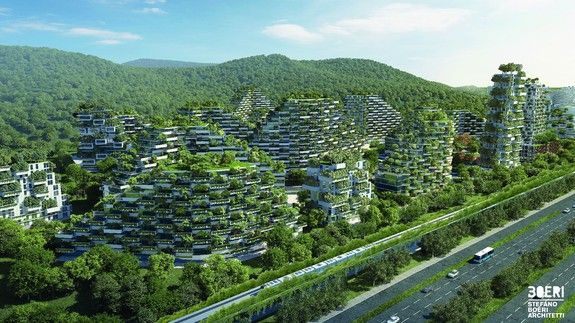China's verdant 'forest city' will fight pollution with a million plants
China has broken ground on a "forest city" in the southern city of Liuzhou. The development, which will span two-thirds of a mile along the Liujiang River, involves blanketing offices, apartments, hotels, and schools with more than a million plants and about 40,000 trees.


If the concept sounds familiar, that's because these buildings are the work of Stefano Boeri Architetti, the same architecture firm behind the two "vertical forest" buildings planned for Nanjing in eastern China.
Liuzhou city officials commissioned the Italian company to build the development, which will host about 30,000 people and be connected to the main Liuzhou city — population 3.8 million — via a fast-rail line used by electric cars.
The forest city, now under construction, is expected to be completed by 2020, the Milan-based architects confirmed by email.
The development is a flashy but tiny effort to combat the dangerous smog and toxic air pollution that's choking China's industrialized cities. It comes as China is building more wind and solar power than any country in the world to slash emissions from coal plants, factories, and vehicles, and to combat climate change.
Stefano Boeri's firm, which recently completed two verdant towers in Milan, is planning to expand into other smoggy cities, including China's Shijiazhuang, Guizhou, Shanghai, and Chongqing.
In the Liuzhou Forest City, buildings, parks, and gardens will absorb almost 10,000 tons of carbon dioxide and 57 tons of fine dust pollutants per year, while producing about 900 tons of oxygen, the architects said in a press release.
By comparison, the two green towers in Nanjing will absorb 25 tons of carbon dioxide and produce 0.06 tons of oxygen.
Beyond sucking up toxic air, the urban greenery is also expected to stifle noise pollution and support biodiversity by providing a habitat for the local birds, insects, and small animals that inhabit Liuzhou.
The project will include residential areas, commercial and recreational spaces, plus two schools and a hospital. Along with plants, the buildings will also feature rooftop solar panels to produce clean electricity and use geothermal energy systems for interior air-conditioning.
Stefano Boeri Architetti said the Liuzhou Forest City represents its broader effort to design a "new generation" of architecture and urban environments to address climate change.

If tree-covered skyscrapers act like enormous air filters, this cluster of buildings will be a clean air oasis.
The verdant towers will help soak up urban air pollution, produce clean oxygen, and boost local biodiversity. The greenery also provides shade on sunny days and acts as an insulating blanket during winter, allowing tenants to use less heating and electricity.
Liuzhou Forest City will span 175 hectares, or 0.67 miles, along the Liujiang River.
If the concept sounds familiar, that's because these buildings are the work of Stefano Boeri Architetti, the same architecture firm behind the two "vertical forest" buildings planned for Nanjing in eastern China.
Liuzhou city officials commissioned the Italian company to build the development, which will host about 30,000 people and be connected to the main Liuzhou city — population 3.8 million — via a fast-rail line used by electric cars.
The forest city, now under construction, is expected to be completed by 2020, the Milan-based architects confirmed by email.
The development is a flashy but tiny effort to combat the dangerous smog and toxic air pollution that's choking China's industrialized cities. It comes as China is building more wind and solar power than any country in the world to slash emissions from coal plants, factories, and vehicles, and to combat climate change.
Stefano Boeri's firm, which recently completed two verdant towers in Milan, is planning to expand into other smoggy cities, including China's Shijiazhuang, Guizhou, Shanghai, and Chongqing.
In the Liuzhou Forest City, buildings, parks, and gardens will absorb almost 10,000 tons of carbon dioxide and 57 tons of fine dust pollutants per year, while producing about 900 tons of oxygen, the architects said in a press release.
By comparison, the two green towers in Nanjing will absorb 25 tons of carbon dioxide and produce 0.06 tons of oxygen.
Beyond sucking up toxic air, the urban greenery is also expected to stifle noise pollution and support biodiversity by providing a habitat for the local birds, insects, and small animals that inhabit Liuzhou.
The project will include residential areas, commercial and recreational spaces, plus two schools and a hospital. Along with plants, the buildings will also feature rooftop solar panels to produce clean electricity and use geothermal energy systems for interior air-conditioning.
Stefano Boeri Architetti said the Liuzhou Forest City represents its broader effort to design a "new generation" of architecture and urban environments to address climate change.

Leave your comment on this story